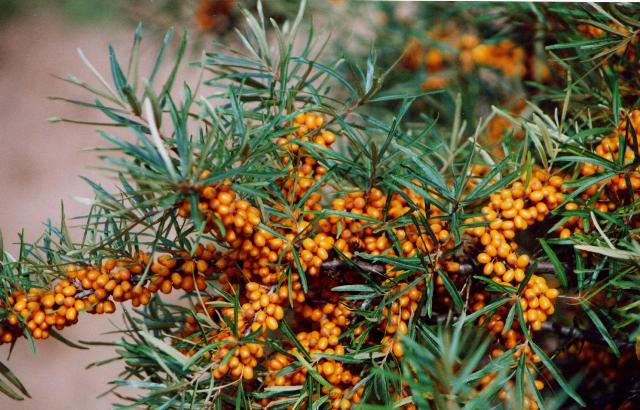Sea Buckthorn Production in Manitoba
Description

The sea buckthorn (Hippophae rhamnoides L.) belongs to the family Elaeagnceae. Sea buckthorn is native to Europe and Asia and was introduced to Canada some time ago. The sea buckthorn is a medium deciduous shrub six to 13 feet (2 to 4 m) in height. The trees are dioecious meaning there are male and female plants. Tremendous potential for functional food and nutraceutical uses. Very high vitamin C and anti-oxidant properties.
Only female plants produce fruit. Unfortunately, plant type cannot be determined until flowers are produced. Flowers are small, yellow and appear before the leaves being produced on three-year-old wood. Sea buckthorn plants are very hardy and can withstand temperatures of -45 to 103 °F (-43 to 40 °C). To ensure adequate pollination and suitable numbers of female trees, it is necessary for the orchard to have between seven and 12% of the trees as pollinators. Too many pollinator trees in the orchard can result in a reduced number of fruit bearing trees and a reduction in yields.
Uses
Most parts of the tree can be used including the bark, leaves, fruits, and seeds. A wide range of products can be made from the tree including: pharmaceuticals, cosmetics, teas, animal feed, sport and health drinks, food (jams and jellies), beverages, dyes, candy, liqueurs, and in brewing.
Site Selection/ Spacing/Rooting Depth
Sea buckthorn does not like dry conditions and grows best in areas receiving 16 to 24 inches (400 to 600 mm) of precipitation. Best growth occurs in deep, well drained, sandy loam soil with high organic matter. Sea buckthorn can be grown in very poor soils including river banks, steep slopes, and acid and alkaline soils. Sea buckthorn is also salt tolerant. Sea buckthorn grows on soils with a pH of 5.5 to 8.3 but does best with soil pH between six and seven. Plants should be spaced three feet (1 m) between plants and 13 feet (4 m) between rows. No information is known about root depth and spread. Sea buckthorn is a nitrogen fixing plant.
Harvesting/Nutritional Value
The fruit is orange when ripe at the end of August/beginning of September and is very difficult harvest. Although the fruit is ripe, it is not easily removed from the tree. Estimates of 600 hours/acre (1500 hours/hectare) for fruit harvesting can be expected. Mechanical harvesters have been tried with little success. Other techniques of removing the branch from the tree work well but it is still very labour intensive. Work is ongoing to find economical ways to harvest the fruit. Expected yields are around 11 to 15 lb. (5 to 7 kg) per plant or 1.8 to 2.2 tons/acre or (4 to 5 t/ha).
